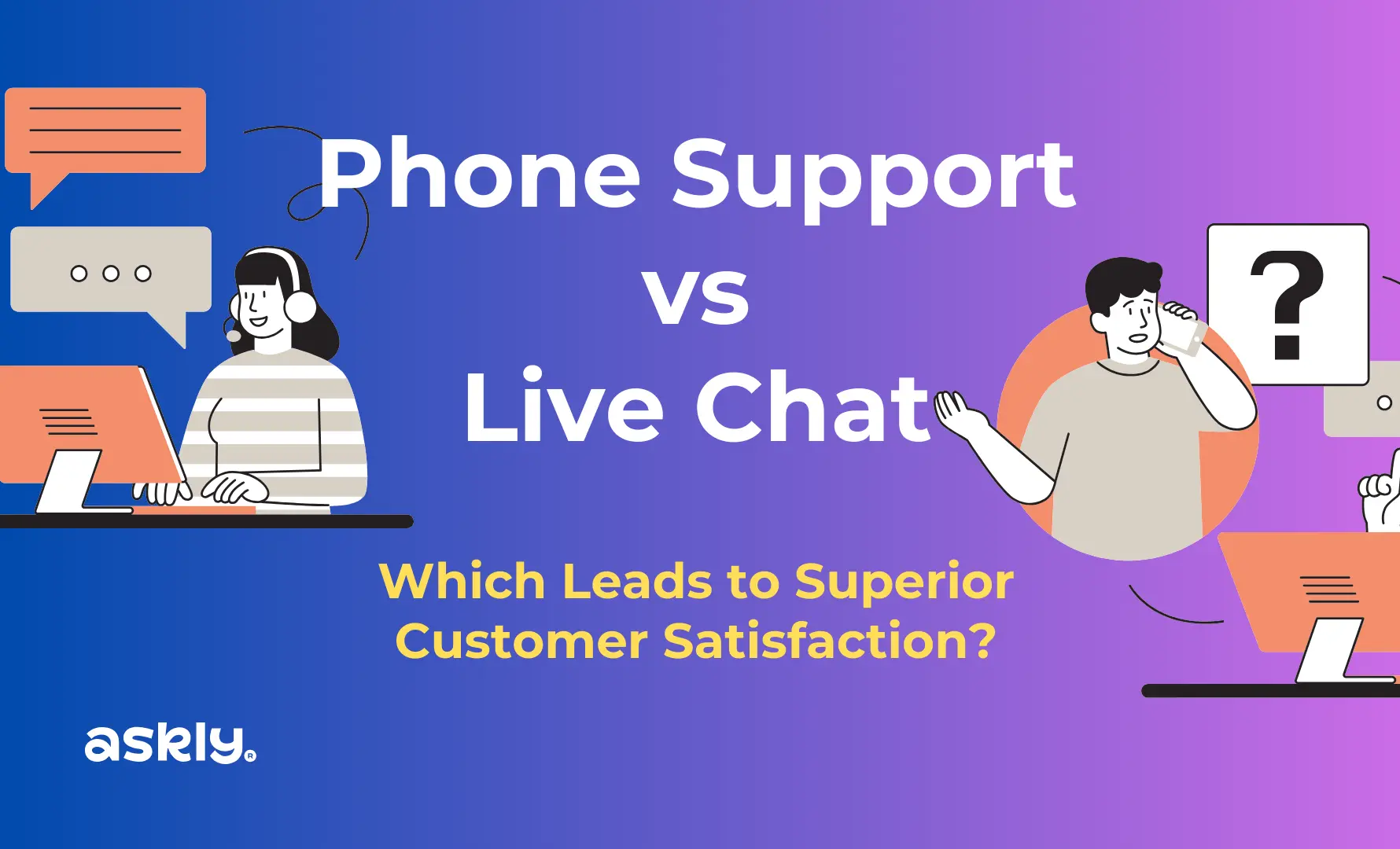A Guide to Outsourcing Website Chat Services

Sandra Roosna
Askly CEO & Founder
Are you feeling overwhelmed managing all aspects of your customer support? It might be time to consider outsourcing your website's chat functions. This solution can not only improve customer satisfaction but also allows you to focus on growing your business. Here's a comprehensive look at the benefits and options available for outsourcing website chat services.
What is Chat-Based Outsourcing?
Chat-based outsourcing involves hiring a third-party provider to manage your website's live chat. This means trained professionals handle customer inquiries, ensuring your visitors receive fast, helpful responses. As customers demand quicker interactions, live chat becomes a necessity, cutting response times significantly.
In today's digital landscape, chat-based outsourcing has evolved into a sophisticated service that goes beyond simple message handling. These providers often employ AI-powered chatbots to handle initial inquiries, seamlessly transferring complex issues to human agents when necessary. This hybrid approach ensures that customers receive immediate attention while also benefiting from the nuanced understanding that only human interaction can provide.
Moreover, chat-based outsourcing services often come equipped with advanced features such as sentiment analysis, which allows them to gauge customer emotions and tailor responses accordingly. This level of personalization can significantly enhance the customer experience, leading to increased satisfaction and loyalty. According to Click4Assistance, live chat is 100 times faster than other digital channels, making it an essential tool for businesses aiming to meet modern customer expectations.
Why Outsource Your Live Chat?
Efficiency and Expertise
Managing live chat internally requires time and skilled labor. Outsourcing transfers this responsibility to experts who are trained to manage customer interactions effectively and are equipped with industry knowledge and best practices. Outsourcing live chat can improve response times and boost customer satisfaction by providing instant support.
These expert teams are often well-versed in various industries, allowing them to quickly understand and address customer concerns. They undergo continuous training to stay updated on the latest customer service trends and technologies, ensuring that your business always offers cutting-edge support. Additionally, many outsourcing providers offer multilingual support, enabling your business to cater to a global audience without the need to hire and train a diverse in-house team.
Cost Savings
Outsourcing reduces upfront investments in hiring and training an in-house team. Additionally, it allows flexibility with service levels, making it cost-efficient, especially for growing businesses with fluctuating needs. Magellan Solutions reports that outsourcing can significantly reduce operational costs associated with maintaining an in-house chat support team.
Beyond the obvious savings on salaries and benefits, outsourcing eliminates the need for expensive software licenses, hardware, and infrastructure maintenance. It also reduces the burden on your HR department, as the outsourcing provider handles all aspects of agent recruitment, training, and management. This allows your business to allocate resources more strategically, focusing on core competencies and growth initiatives.
24/7 Availability
Keeping a live chat running around the clock can be financially draining. By outsourcing, you benefit from continuous service, ensuring customer queries are addressed promptly any time of the day, which is crucial for maintaining international customer relations.
Round-the-clock availability is particularly beneficial for businesses operating in multiple time zones or those with a global customer base. It ensures that your customers can receive support at their convenience, regardless of their location or time of day. This level of accessibility can be a significant differentiator in competitive markets, potentially leading to increased customer loyalty and positive word-of-mouth referrals.
Key Benefits of Outsourcing
- Scalability: Easily adjust the level of service in response to business needs, such as during peak shopping seasons.
- Increased Sales: Quick and effective customer service can lead to reduced cart abandonment and increased conversions.
- Analytics and Insights: Providers often offer analytics tools to track performance and customer interactions, allowing for data-driven improvements.
- Multilingual Support: Many outsourcing providers offer support in multiple languages, expanding your global reach.
- Compliance and Security: Professional outsourcing services are often well-versed in data protection regulations and employ robust security measures.
- Continuous Improvement: Outsourcing partners typically invest in ongoing training and the latest technologies, ensuring your chat service remains cutting-edge.
These benefits contribute to a more efficient and effective customer service operation. For instance, the scalability aspect allows businesses to handle sudden spikes in customer inquiries during promotional periods or product launches without compromising on quality. The analytics provided can offer valuable insights into customer behavior and preferences, informing product development and marketing strategies.
How to Choose a Provider
When selecting a provider, consider the following:
- Integration Capabilities: Ensure the provider can integrate seamlessly with your existing systems and platforms.
- Customization: Look for options that allow you to customize chat windows and responses to align with your brand's voice.
- Security: Data privacy should be a priority. Ensure your provider complies with all relevant regulations.
- Industry Expertise: Choose a provider with experience in your specific industry for more relevant and effective support.
- Performance Metrics: Ask about key performance indicators (KPIs) and how they measure success.
- Technological Capabilities: Evaluate the provider's use of AI, chatbots, and other advanced technologies.
It's crucial to thoroughly vet potential providers to ensure they align with your business goals and values. Request case studies or references from similar businesses in your industry. Consider conducting a trial period to assess the quality of service before committing to a long-term contract. Remember, the right provider should feel like an extension of your own team, representing your brand with the same level of care and professionalism you would expect from in-house staff.
Integrating Live Chat on Your Website
Adding chat functions to your website is straightforward, especially with providers offering plugins for platforms like WordPress. Check out these resources on how to add live chat to your WordPress website and explore the best live chat plugins.
When integrating live chat, consider the placement of the chat widget for maximum visibility without being intrusive. Many businesses find success with a floating chat button that follows the user as they scroll, ensuring help is always just a click away. It's also important to customize the chat window to match your website's design, creating a seamless experience for visitors.
Consider implementing proactive chat invitations based on user behavior, such as time spent on a page or items in the shopping cart. This can help engage customers who might be hesitating or have questions before making a purchase. Additionally, ensure that your chat solution is mobile-responsive, as an increasing number of customers access websites via smartphones and tablets.
The Effectiveness of Website Chat
Live chat not only meets customer expectations for immediacy but also enhances user experience by offering prompt support, essential for online businesses striving to convert visitors into customers. Statistics emphasize that companies utilizing live chat report improvements in response times and customer satisfaction.
The effectiveness of website chat extends beyond just quick responses. It provides a platform for personalized interactions, allowing businesses to build rapport with customers and gather valuable feedback. Website Hub Directory highlights that live chat is particularly effective for collecting customer feedback, which can inform product development and service improvements.
Moreover, live chat can significantly impact sales and customer retention. Studies have shown that customers who engage with live chat are more likely to make a purchase and have a higher average order value. The ability to address concerns and provide product information in real-time can be the deciding factor in a customer's buying decision. Additionally, the convenience of live chat can lead to increased customer loyalty, as users appreciate the quick and effortless support experience.
Conclusion
Outsourcing your live chat function can streamline operations, improve customer engagement, and provide significant cost savings. By leveraging the expertise of dedicated professionals, your business can ensure superior customer interactions without the operational challenges of managing an in-house team. Consider exploring your options to find a service provider that fits your brand's needs and elevate your customer service game today.
For further insights into making the most of live chat, check out the advantages of live chat on website and learn about customer service performance goals to optimize your team's success. By implementing these strategies and leveraging the power of outsourced live chat, you can create a customer service experience that sets your business apart in today's competitive digital landscape.


